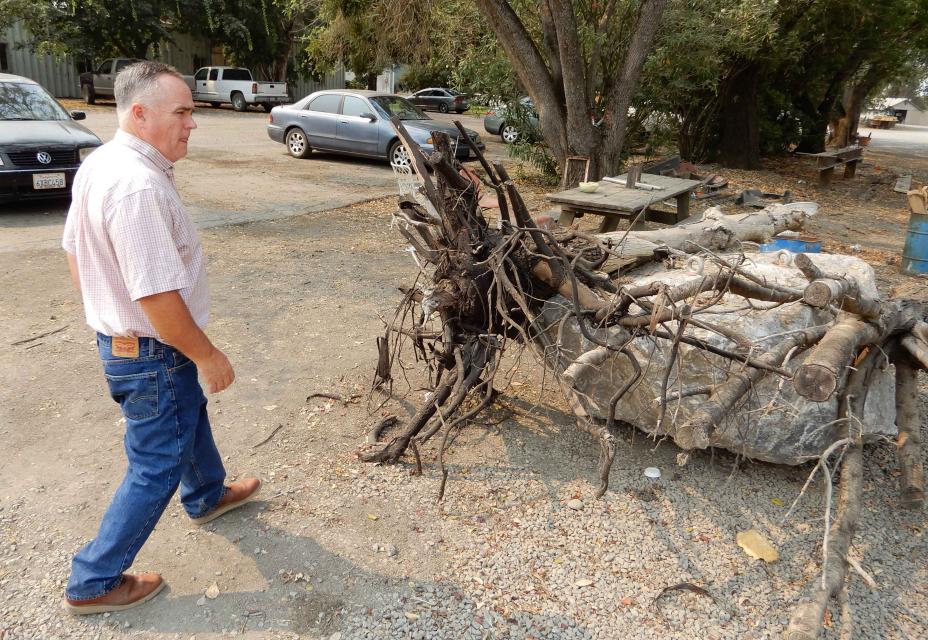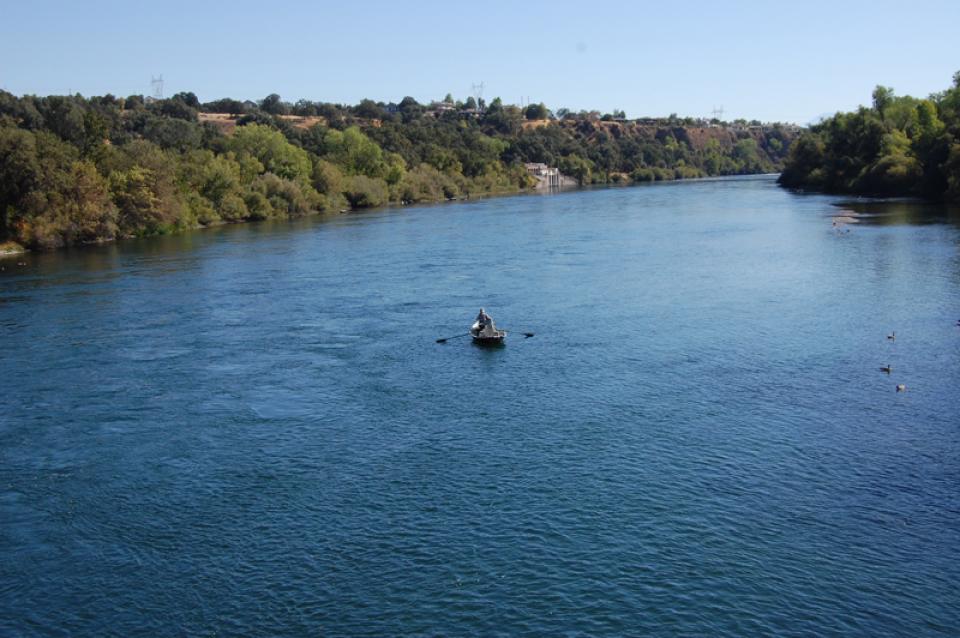When Water Worries Often Pit Farms vs. Fish, a Sacramento Valley Farm Is Trying To Address The Needs Of Both
Dear Western Water readers:
 Farmers in the Central Valley are
broiling about California’s plan to increase flows in the
Sacramento and San Joaquin river systems to help struggling
salmon runs avoid extinction. But in one corner of the fertile
breadbasket, River Garden Farms is taking part in some
extraordinary efforts to provide the embattled fish with refuge
from predators and food to eat.
Farmers in the Central Valley are
broiling about California’s plan to increase flows in the
Sacramento and San Joaquin river systems to help struggling
salmon runs avoid extinction. But in one corner of the fertile
breadbasket, River Garden Farms is taking part in some
extraordinary efforts to provide the embattled fish with refuge
from predators and food to eat.
And while there is no direct benefit to one farm’s voluntary actions, the belief is what’s good for the fish is good for the farmers.
“How well [salmon] do is how well the rest of us do with our water supply,” said Roger Cornwell, general manager of River Garden Farms in Knights Landing, about 30 miles north of Sacramento. “Water is a fundamental business asset … and we’re going to be investing in our water.”
Western Water writer Gary Pitzer examined River Garden Farms’ efforts, why they pursued them and what it could mean for other areas of the Central Valley where salmon are imperiled.
Read the full story here.
Water Around the West
Here are five don’t-miss articles from the last week:
Scientists battle alien snails in SF Bay in effort to restore native oysters. The San Francisco Chronicle’s Peter Fimrite dives into the battle to bring back the long-lost Olympia oysters, California’s only native oyster, which once blanketed subtidal regions from Southern California to southeastern Alaska until they were ravaged by human excess. Restoration efforts are being frustrated by a ravenous invader called the whelk snail, and nobody has figured out a way to stop the slaughter, except by hand-plucking the snails en masse.
Arizona’s plan to withdraw years worth of ‘banked’ CAP water lagging. Tony Davis with the Arizona Daily Star explores how Arizona had the foresight to quietly bank huge amounts of Colorado River water in dozens of large sand and gravel-filled basins until the state is ready to use it, but left a key detail unsettled: how to get it out when it’s needed.
Bird Species Collapse in the Mojave, Driven by Climate Change. Amanda Heidt, writing for KQED, reports on a new study that shows bird populations in the Mojave are plummeting for lack of water, in an imbalance driven by climate change.
Why One Arizona County Could Upend the Southwest’s Drought Plan. Matt Weiser writing in Water Deeply examines how just 500 farmers in one Arizona county may decide the fate of the entire Southwest: By holding tight to their own temporary water supply, they could stall a conservation plan designed to save the entire region from water shortages.
There’s a time bomb for US-Mexico relations ticking underground. Zoe Schlanger, writing in Quartz, explores how little is known about the underground aquifers that extend across the U.S.-Mexico border and how they might be the only sources of water the region will have left when the Rio Grande, hit by a one-two punch of climate change and a booming population, inevitably dries up.
Water Word
 Water Word of the Day: Sacramento
River. Once called “the Nile of the West,” the
Sacramento River drains the inland slopes of the Klamath
Mountains, the Cascade Range, the Coast Ranges and the western
slopes of the northern Sierra Nevada. But reclamation and
leveeing of riparian lands for agricultural and urban use has
reduced critical habitat, one of many factors that have caused an
overall decline in Sacramento River salmon and steelhead runs in
recent years. Read more about the Sacramento River in Aquapedia, our free, vetted
online water encyclopedia.
Water Word of the Day: Sacramento
River. Once called “the Nile of the West,” the
Sacramento River drains the inland slopes of the Klamath
Mountains, the Cascade Range, the Coast Ranges and the western
slopes of the northern Sierra Nevada. But reclamation and
leveeing of riparian lands for agricultural and urban use has
reduced critical habitat, one of many factors that have caused an
overall decline in Sacramento River salmon and steelhead runs in
recent years. Read more about the Sacramento River in Aquapedia, our free, vetted
online water encyclopedia.
At the Foundation
 Join the Foundation for two
noteworthy events coming up — our 35th annual Water Summit on
Sept. 20 in Sacramento, and a free workshop on San Joaquin Valley
land subsidence on Oct. 2 in Fresno. The Water Summit will feature keynote addresses
by U.S. Bureau of Reclamation Commissioner Brenda Burman and
climate scientist Daniel Swain. In addition, top policymakers and
leading stakeholders will provide the latest information and
viewpoints on issues affecting water statewide and across the
West. The
land subsidence workshop at Fresno State will highlight
ongoing land subsidence monitoring, and assistance from
California Department of Water Resources for local agency
compliance with the state’s Sustainable Groundwater Management
Act. Learn more about both here.
Join the Foundation for two
noteworthy events coming up — our 35th annual Water Summit on
Sept. 20 in Sacramento, and a free workshop on San Joaquin Valley
land subsidence on Oct. 2 in Fresno. The Water Summit will feature keynote addresses
by U.S. Bureau of Reclamation Commissioner Brenda Burman and
climate scientist Daniel Swain. In addition, top policymakers and
leading stakeholders will provide the latest information and
viewpoints on issues affecting water statewide and across the
West. The
land subsidence workshop at Fresno State will highlight
ongoing land subsidence monitoring, and assistance from
California Department of Water Resources for local agency
compliance with the state’s Sustainable Groundwater Management
Act. Learn more about both here.
Water Academy
 California thrives on a complex and
diverse network of natural waterways and man-made reservoirs and
aqueducts – including federally, state and locally funded
projects – as well as wild and scenic rivers and natural lakes.
Our poster-size California Water Map
features beautiful photos of California’s natural environment,
rivers, water projects, wildlife, and urban and agricultural
uses. You can learn more about key issues facing California
water, including supply, use, projects, the Sacramento-San
Joaquin Delta, wild and scenic rivers and the Colorado River.
California thrives on a complex and
diverse network of natural waterways and man-made reservoirs and
aqueducts – including federally, state and locally funded
projects – as well as wild and scenic rivers and natural lakes.
Our poster-size California Water Map
features beautiful photos of California’s natural environment,
rivers, water projects, wildlife, and urban and agricultural
uses. You can learn more about key issues facing California
water, including supply, use, projects, the Sacramento-San
Joaquin Delta, wild and scenic rivers and the Colorado River.








